Page 48 of 442
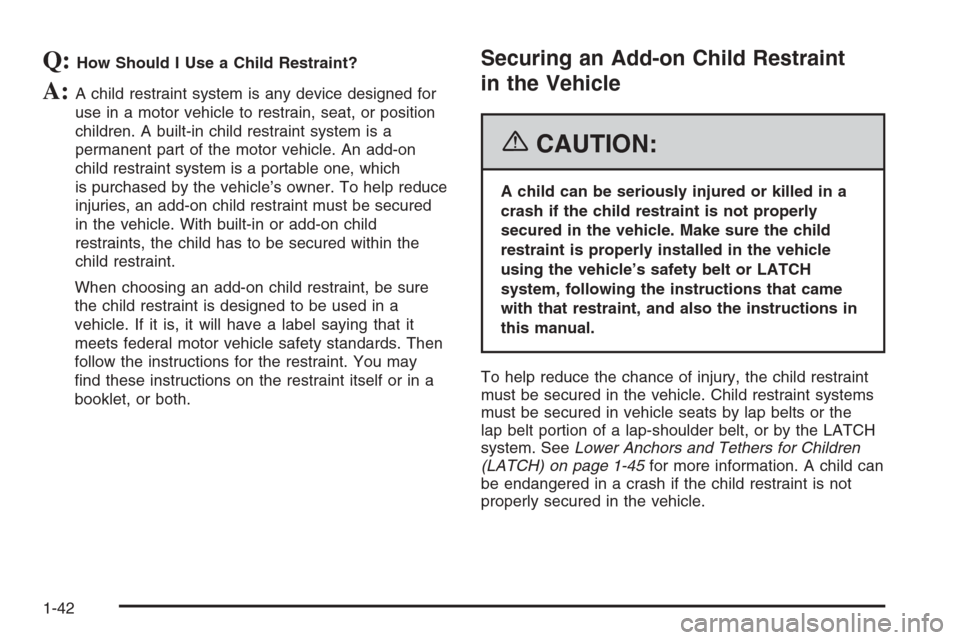
Q:How Should I Use a Child Restraint?
A:A child restraint system is any device designed for
use in a motor vehicle to restrain, seat, or position
children. A built-in child restraint system is a
permanent part of the motor vehicle. An add-on
child restraint system is a portable one, which
is purchased by the vehicle’s owner. To help reduce
injuries, an add-on child restraint must be secured
in the vehicle. With built-in or add-on child
restraints, the child has to be secured within the
child restraint.
When choosing an add-on child restraint, be sure
the child restraint is designed to be used in a
vehicle. If it is, it will have a label saying that it
meets federal motor vehicle safety standards. Then
follow the instructions for the restraint. You may
�nd these instructions on the restraint itself or in a
booklet, or both.
Securing an Add-on Child Restraint
in the Vehicle
{CAUTION:
A child can be seriously injured or killed in a
crash if the child restraint is not properly
secured in the vehicle. Make sure the child
restraint is properly installed in the vehicle
using the vehicle’s safety belt or LATCH
system, following the instructions that came
with that restraint, and also the instructions in
this manual.
To help reduce the chance of injury, the child restraint
must be secured in the vehicle. Child restraint systems
must be secured in vehicle seats by lap belts or the
lap belt portion of a lap-shoulder belt, or by the LATCH
system. SeeLower Anchors and Tethers for Children
(LATCH) on page 1-45for more information. A child can
be endangered in a crash if the child restraint is not
properly secured in the vehicle.
1-42
Page 49 of 442
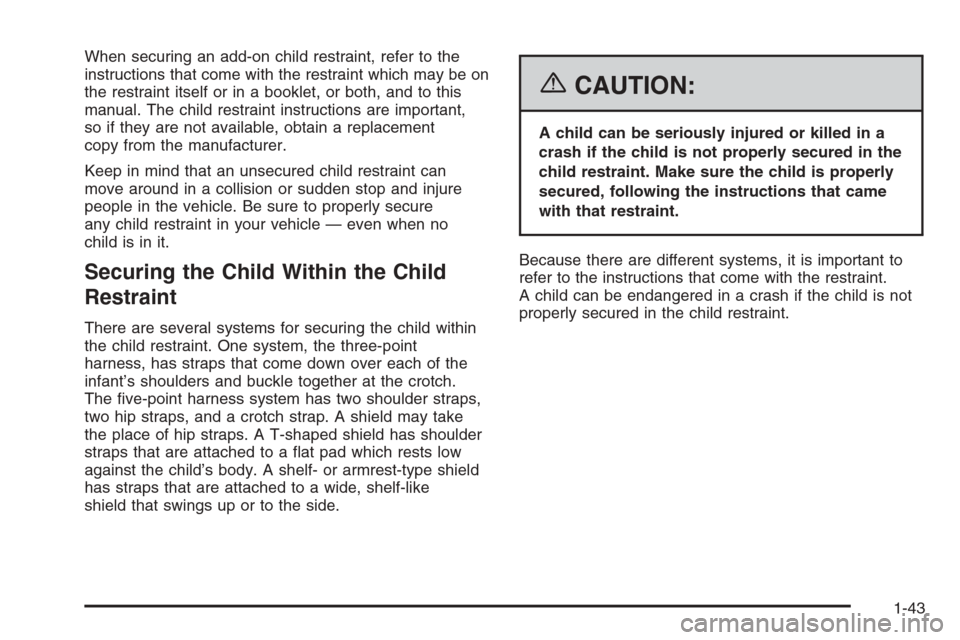
When securing an add-on child restraint, refer to the
instructions that come with the restraint which may be on
the restraint itself or in a booklet, or both, and to this
manual. The child restraint instructions are important,
so if they are not available, obtain a replacement
copy from the manufacturer.
Keep in mind that an unsecured child restraint can
move around in a collision or sudden stop and injure
people in the vehicle. Be sure to properly secure
any child restraint in your vehicle — even when no
child is in it.
Securing the Child Within the Child
Restraint
There are several systems for securing the child within
the child restraint. One system, the three-point
harness, has straps that come down over each of the
infant’s shoulders and buckle together at the crotch.
The �ve-point harness system has two shoulder straps,
two hip straps, and a crotch strap. A shield may take
the place of hip straps. A T-shaped shield has shoulder
straps that are attached to a �at pad which rests low
against the child’s body. A shelf- or armrest-type shield
has straps that are attached to a wide, shelf-like
shield that swings up or to the side.
{CAUTION:
A child can be seriously injured or killed in a
crash if the child is not properly secured in the
child restraint. Make sure the child is properly
secured, following the instructions that came
with that restraint.
Because there are different systems, it is important to
refer to the instructions that come with the restraint.
A child can be endangered in a crash if the child is not
properly secured in the child restraint.
1-43
Page 50 of 442
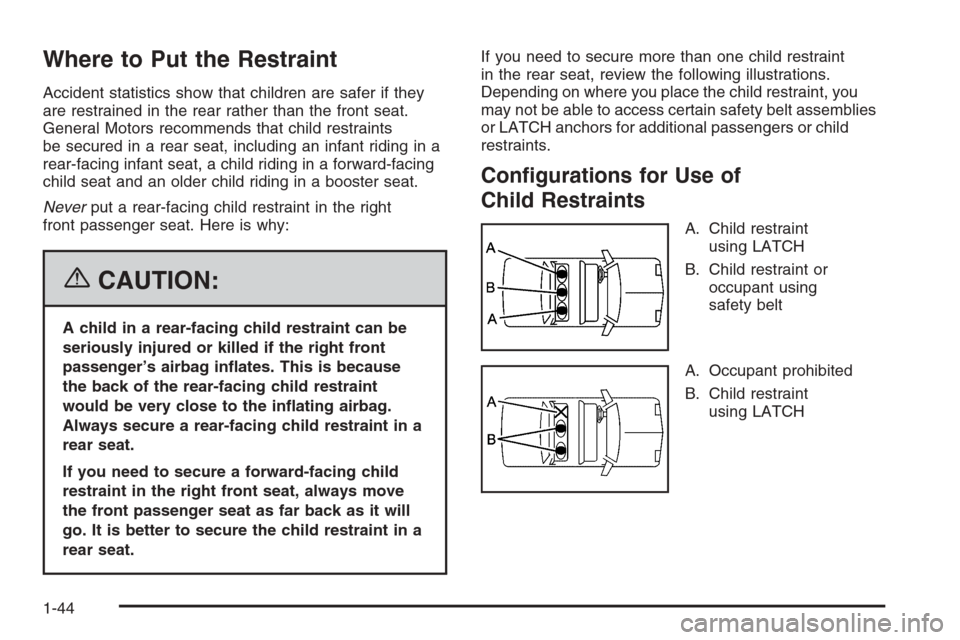
Where to Put the Restraint
Accident statistics show that children are safer if they
are restrained in the rear rather than the front seat.
General Motors recommends that child restraints
be secured in a rear seat, including an infant riding in a
rear-facing infant seat, a child riding in a forward-facing
child seat and an older child riding in a booster seat.
Neverput a rear-facing child restraint in the right
front passenger seat. Here is why:
{CAUTION:
A child in a rear-facing child restraint can be
seriously injured or killed if the right front
passenger’s airbag in�ates. This is because
the back of the rear-facing child restraint
would be very close to the in�ating airbag.
Always secure a rear-facing child restraint in a
rear seat.
If you need to secure a forward-facing child
restraint in the right front seat, always move
the front passenger seat as far back as it will
go. It is better to secure the child restraint in a
rear seat.If you need to secure more than one child restraint
in the rear seat, review the following illustrations.
Depending on where you place the child restraint, you
may not be able to access certain safety belt assemblies
or LATCH anchors for additional passengers or child
restraints.
Con�gurations for Use of
Child Restraints
A. Child restraint
using LATCH
B. Child restraint or
occupant using
safety belt
A. Occupant prohibited
B. Child restraint
using LATCH
1-44
Page 51 of 442
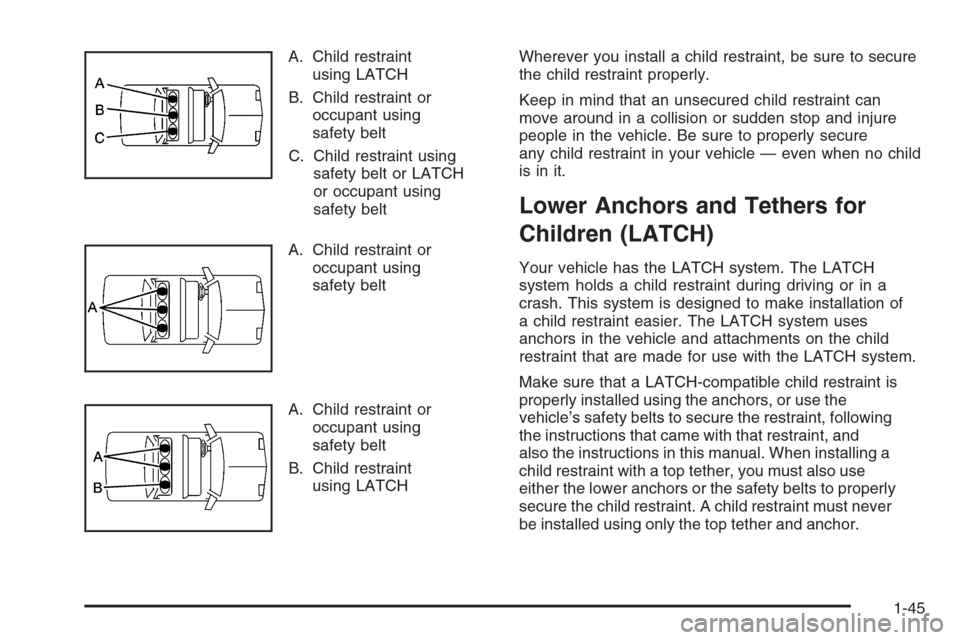
A. Child restraint
using LATCH
B. Child restraint or
occupant using
safety belt
C. Child restraint using
safety belt or LATCH
or occupant using
safety belt
A. Child restraint or
occupant using
safety belt
A. Child restraint or
occupant using
safety belt
B. Child restraint
using LATCHWherever you install a child restraint, be sure to secure
the child restraint properly.
Keep in mind that an unsecured child restraint can
move around in a collision or sudden stop and injure
people in the vehicle. Be sure to properly secure
any child restraint in your vehicle — even when no child
is in it.
Lower Anchors and Tethers for
Children (LATCH)
Your vehicle has the LATCH system. The LATCH
system holds a child restraint during driving or in a
crash. This system is designed to make installation of
a child restraint easier. The LATCH system uses
anchors in the vehicle and attachments on the child
restraint that are made for use with the LATCH system.
Make sure that a LATCH-compatible child restraint is
properly installed using the anchors, or use the
vehicle’s safety belts to secure the restraint, following
the instructions that came with that restraint, and
also the instructions in this manual. When installing a
child restraint with a top tether, you must also use
either the lower anchors or the safety belts to properly
secure the child restraint. A child restraint must never
be installed using only the top tether and anchor.
1-45
Page 53 of 442
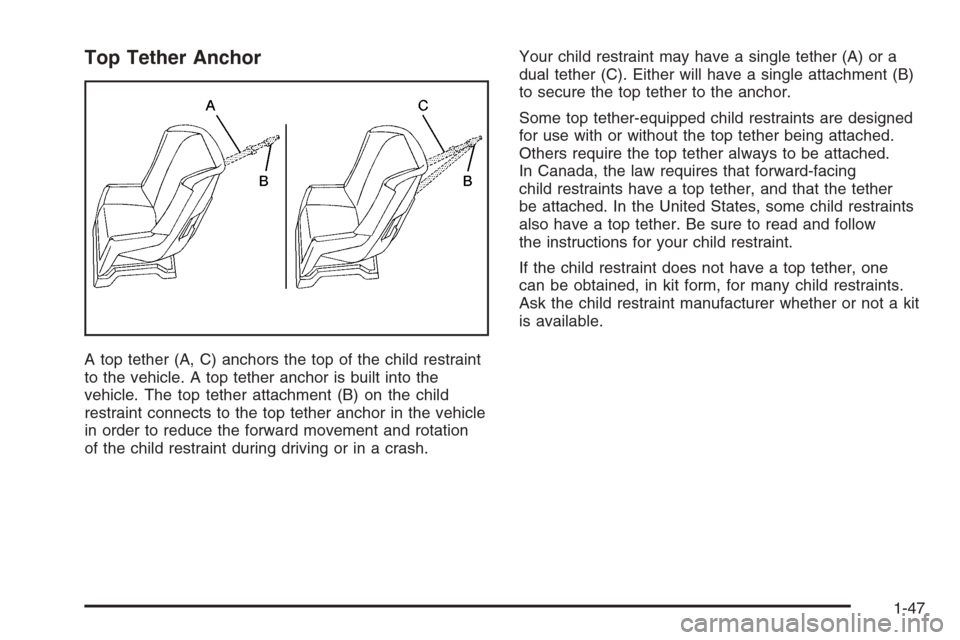
Top Tether Anchor
A top tether (A, C) anchors the top of the child restraint
to the vehicle. A top tether anchor is built into the
vehicle. The top tether attachment (B) on the child
restraint connects to the top tether anchor in the vehicle
in order to reduce the forward movement and rotation
of the child restraint during driving or in a crash.Your child restraint may have a single tether (A) or a
dual tether (C). Either will have a single attachment (B)
to secure the top tether to the anchor.
Some top tether-equipped child restraints are designed
for use with or without the top tether being attached.
Others require the top tether always to be attached.
In Canada, the law requires that forward-facing
child restraints have a top tether, and that the tether
be attached. In the United States, some child restraints
also have a top tether. Be sure to read and follow
the instructions for your child restraint.
If the child restraint does not have a top tether, one
can be obtained, in kit form, for many child restraints.
Ask the child restraint manufacturer whether or not a kit
is available.
1-47
Page 55 of 442
For sedan models, the top tether anchors are located
behind the rear seat on the �ller panel.For MAXX models, the top tether anchors are located
on the back of the rear seatback. Be sure to use an
anchor located on the same side of the vehicle as the
seating position where the child restraint will be placed.
Do not secure a child restraint in the right front
passenger’s position if a national or local law requires
that the top tether be attached, or if the instructions
that come with the child restraint say that the top tether
must be attached. There is no place to attach the
top tether in this position.
Accident statistics show that children are safer if they
are restrained in the rear rather than the front seat.
SeeWhere to Put the Restraint on page 1-44for
additional information. Sedan
MAXX
1-49
Page 56 of 442
Securing a Child Restraint Designed
for the LATCH System
{CAUTION:
If a LATCH-type child restraint is not attached
to anchors, the restraint will not be able to
protect the child correctly. In a crash, the
child could be seriously injured or killed.
Make sure that a LATCH-type child restraint
is properly installed using the anchors, or
use the vehicle’s safety belts to secure the
restraint, following the instructions that came
with that restraint, and also the instructions
in this manual.
{CAUTION:
Each top tether anchor and lower anchor in
the vehicle is designed to hold only one child
restraint. Attaching more than one child
restraint to a single anchor could cause the
anchor or attachment to come loose or even
break during a crash. A child or others could
be injured if this happens. To help prevent
injury to people and damage to your vehicle,
attach only one child restraint per anchor.
1-50
Page 57 of 442

{CAUTION:
Children can be seriously injured or strangled
if a shoulder belt is wrapped around their neck
and the safety belt continues to tighten.
Secure any unused safety belts behind the
child restraint so children cannot reach them.
Pull the shoulder belt all the way out of the
retractor to set the lock, if your vehicle has
one, after the child restraint has been installed.
Be sure to follow the instructions of the child
restraint manufacturer.
Notice:Contact between the child restraint or the
LATCH attachment parts and the vehicle’s safety
belt assembly may cause damage to these parts.
Make sure when securing unused safety belts
behind the child restraint that there is no contact
between the child restraint or the LATCH attachment
parts and the vehicle’s safety belt assembly.Folding an empty rear seat with the safety belts
secured, may cause damage to the safety belt or the
seat. When removing the child restraint, always
remember to return the safety belts to their normal
position before folding the rear seat.
If you need to secure more than one child restraint in
the rear seat, seeWhere to Put the Restraint on
page 1-44. Depending on where you place the child
restraint, you may not be able to access certain safety
belt assemblies or LATCH anchors for additional
passengers or child restraints.
You cannot secure three child restraints using the
LATCH anchors in the rear seat at the same time, but
you can install two of them. If you want to do this, install
one LATCH child restraint in the passenger-side position,
and install the other one either in the driver’s-side position
or in the center position. Refer to the following illustration
to learn which anchors to use.
1-51